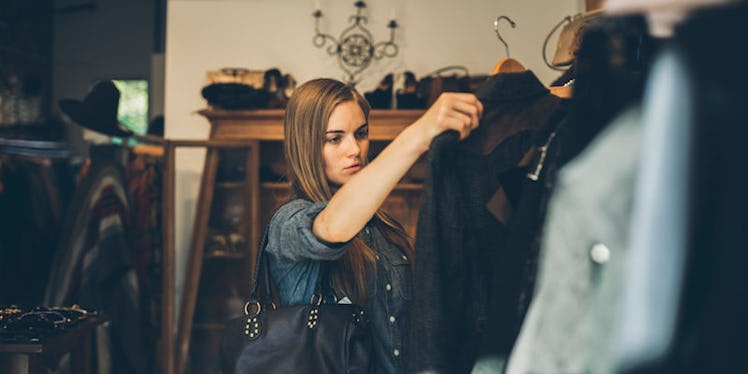
How To Shop For Vintage Clothes That You’ll Actually Wear
Unless there’s a Carrie Bradshaw in your life, learning to shop for vintage alone is impossible.
Perusing the dusty back corners of crowded stores often leads to buying garments that don't fit. After sneezing for about 10 minutes, you leave the shop discouraged.
Even Etsy can be bewildering. How can you tell those are authentic 70s cut-off shorts, not some Urban Outfitters pair from last season?
According to three of Etsy’s highest rated vintage purveyors, it’s a learned skill. We quizzed them about the most important buying tips a newbie can learn.
Speaking from a combined 50 years of experience, the women behind Canary Club Vintage, Vintage Vixen and OGOvintage gave us the real deal on ways to find clothes once worn by Jackie O.
Google first, shop later.
Unlike poking around Nordstrom’s annual sale, finding quality vintage takes a bit of work.
Denise Zeide, who’s sold antique clothing since the late 70s, points to online resources like the Vintage Fashion Guild. The website archives designer labels from decades past, so you’ll know what an old YSL tag looks like before pressing “buy” on a knockoff.
Sellers price styles by age and rarity. If you can identify a coat from the 4os that's really from the 60s, you’ll be able to request a price knockdown.
Vintage shopping is like an antique store, not an IKEA.
April Ainsworth, who’s run Vintage Vixen since 1997, says a newbie should consider how much time he or she is willing to give the hobby. Finding a quality piece takes time and consideration because it’s no longer "ready to wear."
"If it doesn't fit, don't expect that miracles can be worked," Ainsworth advises.
Furs, for example, have historically been items women wore their whole lives. Nicole Byers, from Canary Club Vintage, says furs are infamous for matting and tangling around the cuffs and neck.
Uncovering the perfect coat takes time, so don’t think you’ll be able to duck in and out of the store in just an hour.
"Never buy a piece of vintage for yourself without trying it on to make sure it fits you the way you want it to fit you," Byers adds.
Don’t kid yourself about size and skill.
All three ladies emphasize the importance of considering how much seamstress skill you possess before investing emotion and money into a piece.
Byers explains how hems, underarms and buttons often need to be replaced, as do zippers sewn in half a century ago. Make sure you’re prepared to pay for a tailor if you can’t do the work.
It’s not just closures and snaps that require attention, either. Byers says dresses from the 30s and 40s may be crafted from material that’s difficult to launder.
"A lot of times with vintage you see certain types of fabric that are not necessarily used anymore in modern clothing," she adds. "You want to try to get an idea of what that fabric content is."
Don’t expect to throw vintage crepe in the laundromat’s dryer for a tumble. It’s very delicate and will require extra love.
Think of it like an old lady. Your garment has led a whole life before you picked it up.
Take it in with four senses.
Once you've fallen in love with a piece, Ainsworth recommends taking exact steps to make sure it's in good condition.
Thrift stores rarely have exchange policies.
"One really good tip is to just run your hands over the whole garment and see it in a good, good light," Ainsworth says, explaining how dressing room light is rarely reliable. "It might have holes it that you can see until broad daylight."
Zeide, who specializes in couture, advises luxury buyers to look for trademarks of the brand. Specific garments will have telltale hand stitching around the zipper’s base and in the lining of the garment.
The only place you shouldn’t find stitches is around the label, which is a red flag indicating someone might have falsely sewn in a designer’s name in place of the original tag.
For her part, Ainsworth advocates using your nose.
"If you have a good shop, you can expect things to feel good when you get them. And look good. And smell good. Nobody wants to smell like a thrift store," she says.
Shopping online? It’s perfectly okay to ask the seller how the item smells.
Poke around the trouble zones.
When Byers sees an item she loves, she strategically approaches it.
"The first place, as a seller, that I always look -- even when I'm buying vintage for myself -- is at the underarm," she admits. "They're called housedresses for a reason. They were worn to do housework. So, sometimes people get a little funky when they're doing housework, so there are going to be sweat marks."
These are old items and sometimes fabric just begins to give out. In delicate silks from the 20s and 30s, the material tends to thin and shatter, wearing through in a way that requires a skilled tailor to patch up.
Ainsworth also says if items are located on high shelves and need to be reached by an employee, they're probably the real deal.
Online shopping is a two-way street.
Laptop shopping eliminates the physical element of thrifting, but that's not your problem. Your only responsibility lies in accurately measuring your body, as vintage sizes don't correspond to sizes today.
All three experts fully expect customers to treat them as a proxy, answering garment questions in detail and providing responses largely within the hour. Vintage is a hobby, so don't hesitate to treat vendors like your new best friends.
"Expect details from your seller," Ainsworth says. "Is it actually made in the 40s or is it inspired by the 40s? It should clearly say. There shouldn't be slippery language, there."